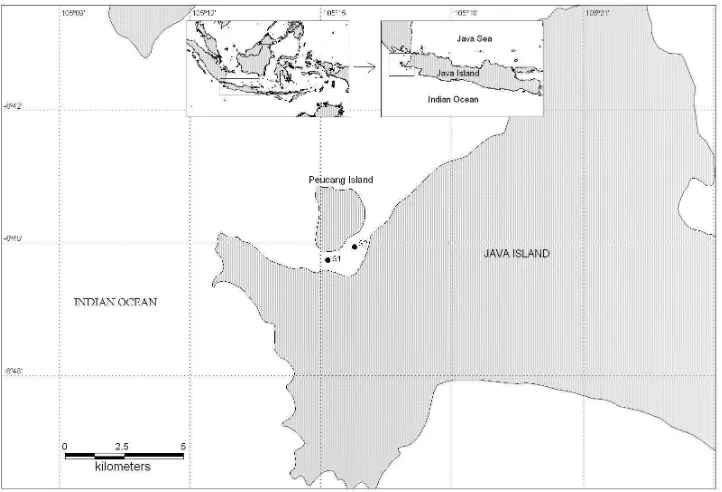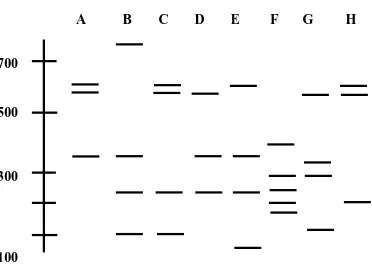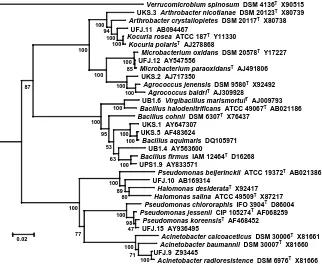Original paper
DIVERSITY OF CULTURABLE BACTERIAL COMMUNITY
ASSOCIATED WITH THE CORAL Galaxea fascicularis
FROM UJUNG KULON, INDONESIA
Agus Sabdono1*, Ocky Karna Radjasa1, Rudiger Stöhr2, and Elena Zocchi3
1)
Centre for Tropical Coastal and Marine Studies, Diponegoro University, Semarang Indonesia
2)IFM-GEOMAR, Kiel, Germany
3)Department of Experimental Medicine, University of Genova, Genova Italy
Received: August 11, 2005 ; Accepted: September 30, 2005
ABSTRACT
Coral reefs are the most diverse marine ecosystems; however, little is known about their microbial diversity in these ecosystems. The present study is aimed at investigating the general insights into the diversity of the bacterial community associated with the coral Galaxea fascicularis. A culture collection of 45 bacteria associated with coral G. fascicularis from Ujung Kulon, Indonesia was established by plating on Zobell’s 2214E. Isolates were screened by means of RLFP and sequencing of representative 16S rDNAs. Using the restriction enzyme HaeIII, isolates were classified into 8 pattern group. The sequence results indicated that a high diversity of bacterial phylotypes was present within the coral Galaxea fascicularis. In general, there are three major groups of bacteria: (i) members of the division Firmicutes , (ii) Actinobacteria, and (iii) γ-proteobacteria. Phylogenetic data on microbial community composition in coral G. fascicularis will help in the rational selection of culture conditions to improve the diversity of bacteria and the knowledge on the physiological, biochemical, genetic, and molecular properties of coral bacteria.
Keywords: Galaxea fascicularis, 16S rDNA, RFLP, diversity, Ujung Kulon
*Correspondence: phone/fax 024-7474698; e-mail: agus_sabdono@yahoo.com
INTRODUCTION
Coral reefs are among the most ancient structures on earth built by living organisms. Reefs are scatterred over an area of 190 million km2 wherever a suitable substratum lies within the lighted waters of tropics beyond the influence of continental sediments. These are deterministic phenomena of sedentary organisms with high metabolism living in
warm marine waters within the zone of strong illumination.
two reasons why this coral was chosen, first, resistance in high sedimentation, and second, in the previous study found that this culturable bacterial community associated with G. fascicularis possesses antibacterial property against shrimp pathogenic bacterium Vibrio harveyi.
It is well understood that corals harbor diverse microbial communities (Pascal and Vacelet, 1981). Their surface is covered by muco-polysaccharides, which provides a matrix for bacterial colonization leading to the formation of biofilm-forming microbial communities. Mucus-covered coral surfaces are often colonized by bacteria and other micro-organisms (Kim, 1994). However, a few studies have suggested that corals may be associated with specific bacteria. Rohwer et al. (2001) stated that differences in the composition of the surface mucus produced by specific corals resulted in different populations of associated microbes. Furthermore, Ritchie and Smith (1995) showed that mucus-associated bacteria had specific carbon source utilization patterns that were consistently associated with certain coral species and varied among different species of coral. However, still many questions evoke about the specificity and dynamics of association between bacteria and corals, even Frias-Lopez et al (2002) stated that corals harbor unique microbes inconsistencies across studies. Fuhrman and Campbell (1998) stated that the majority of microbes cannot be cultured using standard methodologies. In addition, Rohwer et al. (2001) showed that the microbial diversity associated with corals can be greatly underestimated when relying on culture-based methods.
The understanding of population structure in natural bacterial communities has been significantly improved by the availability of molecular tools for community analyses in microbial ecology. The use of rDNA sequence analyses for the investigation of microbial community
composition offers new perspectives on the traditional phenotypic classification systems. The differences of 16S rDNA sequences provide more complete understanding of microbial phylogeny and the identification of bacteria (Gray and Herwig, 1996). However, analysis of microbial communities based on 16S rDNA is restricted to the phylogenetic nature of grouping, and is not appropriate to investigate a functional group of different species in the bacterial community (Goebel and Stackebrandt, 1994). Variation in the 16S rDNA genes as reflected in RFLP were used to classify isolates. This article describes the characterization of bacteria associated with coral G. fascicularis using culture-based methods. Our results show that microbial diversity on coral G. fascicularis is very high.
MATERIALS AND METHODS
Sampling and isolation of bacteria associated with coral
G. fascicularis is found on open reef
bottoms and form morphologically similar colonies of individual, upright tubes. Specimens of the hard corals G. fascicularis were collected by scuba diving
blade. The resultant tissues were serially diluted, spread on ½ strength ZoBell 2216E marine agar medium and incubated at room temperature for 48 hours. On the
basis of morphological features, colonies were randomly picked and purified by making streak plates (Madigan et al. 2000).
Fig. 1 Map of sampling sites
PCR amplification and RFLP analysis
Bacterial strains were cultured at room temperature on half-strength ZoBell 2216E agar plates. After harvest, DNA was extracted by five cycles freeze (-800C) and thaw (950C). PCR was performed with an Eppendorf Mastercycler (Eppendorf Inc., Germany) as follows: 2 µl template DNA, 40 pmol of each of the appropriate primers, 125 mol of each deoxyribonucleoside triphosphate, 5 µl of 10 x RedTaqTM PCR buffer (Sigma, Germany), 1.2 mg ml-1 (final concentration) bovine serum albumin (Sigma) and 0.75 unit RedTaqTM DNA polymerase (Sigma) were adjusted to a final volume of 50 µl with sterile water (Sigma). A PCR run comprised 40 cycles with denaturing conditions for one minute at 95°C, annealing for one minute at 70 °C
and extension for two minutes at 72 °C, respectively. The PCR products were separately digested with restriction endonucleases HaeIII (Ulrich and Wirth., 1999). The gels were stained with ethidium bromide and finally documented with camera. Isolates with identical restriction patterns were designated as a single 16S rDNA genotype group.
Sequencing and phylogenetic analysis
sequencer (the ALF DNA sequences: Pharmacia LKB Biotech, Uppsala, Sweden). Representative of groups were used for sequencing. The resulting 16S rRNA sequences corresponding to the genotype, respectively, were analyzed for homologies with sequences in the data base using Fasta searching. The determined 16S rRNA sequences and various of 16S rRNA of reference strains were also aligned using Clustal W. Neighbour-joining method was used to calculate the distant matrix and to construct the phylogenetic tree.
RESULTS AND DISCUSSION
Coral bacterial isolates displayed a wide variability of morphological features after growth on Zobell’s2216E marine agar. Selected bacterial colonies were subcultured and purified. The rDNA of these isolates could be amplified resulting in a characteristic single band of about 1500 bp. Restriction analysis of the PCR products of the 45 isolates using the restriction endonuclease HaeIII revealed 8 restriction patterns as presented in Fig. 2.
Fig. 2. RFLP patterns among coral bacteria as digested by HaeIII enzyme
The 16S rDNA characterization and distribution of each phylotipe is summarized in Table 1. As shown in the phylogenetic tree, the position of
representative phylotypes reflected the different groups identified by RFLP (Fig.
3)
A
B C D E F G H
700
500
300
Table 1. Phylogenetic characterization and distribution of phylotype
Phylotype No. of strain Percentage Closest species Homology (%)
Acinetobacter radioresistence DSM 6976T X81666
UFJ.9 Z93445
Acinetobacter baumannii DSM 30007T X81660
100
Acinetobacter calcoaceticus DSM 30006T X81661
71
UFJ.15 AY936495
Pseudomonas koreensisTAF468452 Pseudomonas jessenii CIP 105274T AF068259
47
Pseudomonas chlororaphis IFO 3904T D86004
98
100 100
Halomonas salina ATCC 49509T X87217 Halomonas desiderataT X92417
UFJ.10 AB169314
80
Pseudomonas beijerinckii ATCC 19372T AB021386
89
77
100
UPS1.9 AY833571
Bacillus firmus IAM 12464TD16268
UB1.4 AY563600
Bacillus cohnii DSM 6307T X76437
53
Bacillus halodenitrificans ATCC 49067T AB021186
UB1.6 Virgibacillus marismortuiT AJ009793
95 100
Agrococcus baldriTAJ309928 Agrococcus jenensis DSM 9580T X92492
UKS.2 AJ717350
100
Microbacterium paraoxidansTAJ491806
UFJ.12 AY547556
Microbacterium oxidans DSM 20578T Y17227
85
100 100
Kocuria polarisT AJ278868 Kocuria rosea ATCC 187T Y11330
UFJ.11 AB094467
100
Arthrobacter crystallopietes DSM 20117T X80738
100
UKS.3 Arthrobacter nicotianae DSM 20123TX80739
94
Verrucomicrobium spinosum DSM 4136T X90515
0.02
Fig. 3. Phylogenetic tree of bacteria associated with coral G. fascicularis isolated from
Ujung Kulon Indonesia. Verucomicrobium spinosum was used as out group. Bar indicated 2% dissimilarity of sequences.
In this regard the 16S rDNA sequencing assist resolve the exact taxonomic position of coral bacteria, and provided more detail information on their phylogenetic position among their closest relatives. Although restriction patterns
proportion of total strains (2.22%). The application of a single restriction enzyme (HaeIII) to characterize bacterial communities has recently been demonstrated by Ulrich and Wirth (1999) and Ravenschlag et al. (1999), and HhaI (Radjasa, et. al. 2001). Urakawa et al. (1999) reported that among 4 base specific restriction endonucleases (HhaI, DdeI,
RsaI, and Sau3AI), HhaI gave the clearest
RFLP patterns, and our result also clearly demonstrated its differentiation. Other parameters like season, time interval, and phytoplankton were not observed, since the primary objective was to provide a first assessment on the diversity of culturable coral bacteria in the marine national park from the time of sampling. However, this is likely to have a significant impact on the types of culturable bacteria obtained, just as would different types of culture media.
CONCLUSION
The present study indicates that using a culture dependent 16S rDNA–based approach it is possible to explore the diversity of culturable coral bacteria and their phenotypic traits. The implementation of the 16S rDNA approach has developed the field of microbial ecology. The phylogenetic position of environmental bacterial populations in the evolutionary tree could be determined and traced precisely by using this approach even in those complex ecosystems. This approach will be useful to increase the knowledge on the physiological, biochemical, genetic, and molecular properties of coral bacteria.
ACKNOWLEDGEMENT
This work was part of collaborative project with IFM-Geomar, Kiel, Germany and
Department of Experimental Medicine, University of Genova, Italy. This research was supported by Riset Unggulan Terpadu
International (RUTI) III: Marine No.
23A/SP/RUTI/KRT/2004, tanggal 1 April 2004.
REFERENCES
Frias-Lopez J, Zerkle AL, Bonheyo GT, Fouke BW 2002. Partitioning of bacterial communities between seawater and healthy, black band diseased, and dead coral surfaces.
Appl. Environ. Microbiol. 68:2214–
2228
Fuhrman, J.A. and L. Campbell. 1998. Microbial microdiversity. Nature 393:410-411
Pascal H, and Vacelet E 1981. Bacterial utilization of mucus on the coral reef of Aquaba (Red Sea). Proc 4th
Int. Coral. Reef. Symp 1:669–677
Goebel, B.M. and E. Stackebrandt 1994. Cultural and phylogenetic analysis of mixed microbial populations found in natural and commercial bioleaching environments. Appl.
Environ. Microbiol. 60: 1614-1621
Gray, J.P. and R.P. Herwig 1996. Phylogenetic analysis of the bacterial communities in marine sediments. Appl. Environ. Microbiol. 62: 4049-4059 western Pacific Ocean Based on16S Ribosomal DNA Analysis.
Rohwer, F., M. Breitbart, J. Jara, F. Azam and N. Knowlton 2001. Diversity of bacteria associated with the Caribbean coral Montastrea franksi.
Coral. Reefs 20: 85-91
Ravenschlag, K., Sahm, K., Pernthaler, J., and Amann, R. 1999. High bacterial diversity in permanently cold marine sediments. Appl. Environ.
Microbiol. 65:3982–3989.
Ritchie KB, Smith GW. 1995. Preferential carbon utilization by surface bacterial communities from water mass, normal, and white-band diseased Acropora cervicornis. Mol.
Mar. Biol. Biotechnol. 4:345–354
Ulrich, A., and Wirth, S. 1999. Phylogenetic diversity and populations densities of culturable cellulolytic soil bacteria across an agricultural encatchment. Microb.
Ecol. 37:238–247.
Urakawa, H., Kita-Tsukamoto, K., and Ohwada, K. 1999. Restriction fragment length polymorphism analysis of psychrophilic and psychrotrophic Vibrio and
Photobacterium from the
northwestern Pacific Ocean, and Otsuchi Bay, Japan. Can. J.


